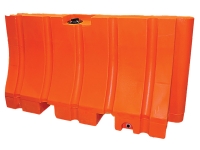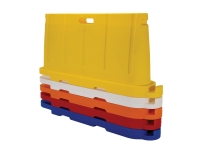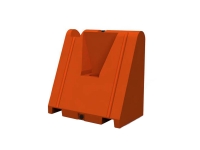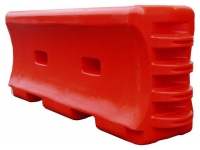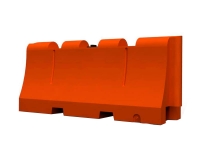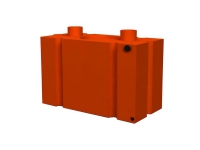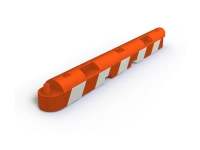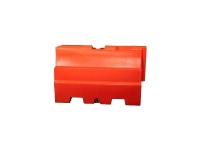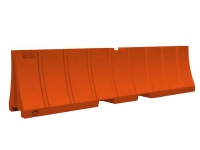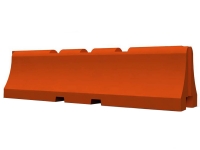Water Filled Barriers & Barricades
Increase Security & Protect From Impacts - Various Sizes & Six Colors
Additional Information
Water or sand-filled barricades/barriers are designed to be easily transported to locations without the use of heavy-duty lifting equipment. As the name suggests, water or sand can be used to fill the barrier to make it an immovable object, thereby filling the purpose of preventing access to certain perimeters. The benefit of purchasing water filled barricades over concrete units is that they are less expensive, costs less to transport, and can easily be moved and stored for later use. Our barriers meet federal highway code "NCHRP 359".
Water & Sand Filled Traffic Barriers
We offer many plastic water or sand-filled barriers, which are a stable, robust, and sound way of controlling traffic. Water filled barricades and sand-filled barriers can be stacked or interlocked; this allows you to create a continuous line of traffic drums or traffic barriers to safely block access to certain areas such as active construction sites. Sand and water filled traffic barriers are also used to delineate lanes in addition to protecting pedestrian traffic from vehicles in large crowds such as protests.
Water fillable barriers and sand-filled jersey barricades are typically large, hollow barricades that are made from high-quality UV resistant polyethylene. These attributes make plastic jersey barriers ideal for outdoor use as it allows them to withstand cold and high temperatures. These barriers are available in several colors; however, the most common is safety orange as it is highly visible.
These are one of the most commonly used safety barriers for the protection of pedestrians and workers in roadside construction as they can absorb high impact by speeding cars. Typically, the polyethylene shell is stable or in other words, can be filled with water or sand.
- Water filled barriers are usually used for temporary barricades.
- Sand-filled barriers form a permanent option.
Product Types and Options
Water filled barricades and sand-filled barriers offer reliable protection against unsolicited access to restricted areas and vehicular impacts. The range of water and sand fill barriers are relatively lightweight before being ballasted, which makes them easy to transport and set-up.
These barriers and barricades include - stackable safety barriers, plastic jersey wall barriers, half, and full wall barricades. Each one comes in different dimensions and wall thickness:
- For example, stackable safety barriers typically weigh 50 lbs to 150 lbs when empty.
- Depending on the specific barrier option, they measure anywhere between 23″ to 120″ in length.
Water filled barricades and sand-filled barriers can also be interconnected to form a line or stack which can save space and make storage/shipping easier.
Plastic jersey barriers also have built-in areas to accommodate barricade lights. Barricade lights are beneficial in nightwork applications as they can warn vehicles and pedestrians of roadside construction or other such hazards.
Each barrier comes with caps or lids on top, which aid in the process of filling water or sand into the shell while a drain plug near the bottom is provided for quickly emptying the barriers.
Where can they be used?
Water filled barricades and sand-filled barriers are energy-absorbing devices which are specially designed to stop errant vehicles safely. They can also be used to cordon off designated areas such as active construction sites and roadside excavations for the safety of workers and pedestrian/vehicular traffic.
In cross lane situations, wate filled barriers can be used as the primary method for "channelization" where there is a high potential for head-on collisions. These barriers usually have a broader base:
- For example, water-filled jersey barricades have a broad base and slope upwards to the top rail width of 6" to 9".
- Typically, water-filled barricades and sand-filled barriers can also provide up to 43 mph to 62 mph work zone barrier protection
Hence, these fillable barrier options can be used at or around the site of commercial renovations, construction projects. These are also an excellent option for those looking to protect worksites and section them off while saving money. Each barrier can create a heavy-duty wall solution when filled with water or sand, which won't fall or tip in even windy conditions.
Water filled barricades and sand-filled barriers can, therefore, be particularly useful in the following areas:
- Construction sites
- Roadside excavations
- Bike paths
- Parade routes
- Gate approaches
- For areas vulnerable to terrorist attacks
- Guard units
- Border patrol areas
- Flight lanes
- Airports
- Race tracks
- Special events
Benefits of Water and Sand Filled Traffic Barriers
Water filled barricades and sand-filled barriers provide numerous benefits, chief among them are increased safety for motorists and construction/roadside workers. Specifically, the benefits of water filled jersey barricades and sand fillable barricades include:
- Increased safety for vehicular and pedestrian traffic by reducing exposure in work zone areas
- Flexible usage as each plastic barrier can be used empty or with varying degrees of ballast
- Increased visibility as the bright color ensures that they are more visible than traditional concrete barriers
- They can also be connected easily end to end or stacked
- Water fillable barricades are easy to transport
- Sand-filled barriers provide a more permanent solution
- When filled with water or sand, these barrier options are not easy to move, as they can weigh up to 1528 lbs to 1739 lbs or more
Shipping and Transportation
Please note that specific barriers might require freight shipping, which can incur an additional cost.
Water or sand-filled barricades/barriers are designed to be easily transported to locations without the use of heavy-duty lifting equipment. As the name suggests, water or sand can be used to fill the barrier to make it an immovable object, thereby filling the purpose of preventing access to certain perimeters. The benefit of purchasing these barricades over concrete units is that they are less expensive, costs less to transport, and can easily be moved and stored for later use. Our barriers meet federal highway code "NCHRP 359".


